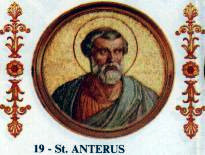Top Qs
Timeline
Chat
Perspective
August 5 (Eastern Orthodox liturgics)
From Wikipedia, the free encyclopedia
Remove ads
August 4 - Eastern Orthodox liturgical calendar - August 6

All fixed commemorations below are observed on August 18 by Eastern Orthodox Churches on the Old Calendar.[note 1]
For August 5, Orthodox Churches on the Old Calendar commemorate the Saints listed on July 23.
Feasts
Saints
- Hieromartyrs Antherus (236)[4][note 2] and Fabian (Fabianus) (250),[6][7][note 3] Popes of Rome.[1]
- Martyr Pontius, at Cimella in Gaul (257)[1][8][9]
- Martyr Eusignius of Antioch (362)[1][10][11][note 4]
- Righteous Nonna (374), wife of Gregory of Nazianzus the Elder and mother of St. Gregory the Theologian.[1][13][14]
- Martyrs Cantidius and Cantidianus, brothers, of Egypt, by stoning (4th century)[1][15][note 5]
- Saint Therissos (Thyrsos), Bishop of Karpasia, Cyprus.[18][19][note 6]
- Saint Euthymius I, Patriarch of Constantinople (917)[1][20]
Remove ads
Pre-Schism Western saints
- Saint Memmius (Menge, Meinge), Founder and first Bishop of Châlons-sur-Marne in France, and Apostle of the region (c. 300)[5][note 7]
- Twenty-three (23) Martyrs of Rome, on the Salarian Way in Rome, under Diocletian (303)[5][note 8]
- Saint Emygdius (Emidius), a saint whose relics were venerated in Ascoli in Italy (c. 303)[5][note 9]
- Martyr Afra, in Augsburg in Germany, under Diocletian (c. 304)[5][note 10]
- Saint Paris, Bishop of Teano near Naples in Italy (346)[5][12]
- Saint Cassian of Autun, Bishop of Autun in France, 314-350, he succeeded St Reticius and was famous for his miracles (c. 350)[5][12]
- Saint Venantius, the most famous of the ancient Bishops of Viviers in France (544)[5]
- Martyr Oswald of Northumbria, King of Northumbria (642)[1][12][21][22][23][note 11]
- Saint Abel of Reims, Archbishop of Rheims in France (c. 751)[5][24]
- Saint Theodoric, Bishop of Cambrai-Arras in the north of France c 830-863 (863)[5]
- Saint Gormcal, Abbot of Ardoileán in Galway in Ireland (1016)[5][25]
Post-Schism Orthodox saints
- Saint Theoctistus, Bishop of Chernigov (1123)[9][26][note 12]
- Venerable Monk-martyr Job the Gorge-dweller (Job of Ushchelsk), on the Mezen River (Solovki) (1628)[1][9][27]
- New Martyr Christos of Preveza, at Kos (1668)[1][28]
- Venerable Eugenius of Aetolia (1682)[1][19][29][note 13]
- Saint John Jacob the Chozebite, of Neamț (1960)[9][30][31][note 14][note 15] (see also: July 28 - Greek)
New martyrs and confessors
Remove ads
Other commemorations
Icon gallery
- Hieromartyr Pope Anterus.
- Hieromartyr Fabian (Fabianus).
- Consecration of Euthymius as Patriarch of Constantinople.
- Martyr-King Oswald of Northumbria, King of Northumbria.
- Saint Abel of Reims.
- New Hieromartyr Simon (Shleyev), Bishop of Ufa.
Notes
- The notation Old Style or (OS) is sometimes used to indicate a date in the Julian Calendar (which is used by churches on the "Old Calendar").
The notation New Style or (NS), indicates a date in the Revised Julian calendar (which is used by churches on the "New Calendar"). - "At Augsburg, the birthday of St. Afra, martyr. After being converted from Paganism by the instructions of bishop St. Narcissus, and being baptized with all her household, she was delivered to the flames for the confession of Christ."[12] She was venerated there from early times and the monastery of that city was dedicated to her.
- The successor of St Edwin on the throne of Northumbria in England, he was baptised in exile on Iona. In 635 he defeated the Welsh King Cadwalla and so his real reign began. One of his main aims was to enlighten his country and so he called on St Aidan to help him. In 642 he fell in battle at Maserfield fighting against the champion of paganism, Penda of Mercia. He has always been venerated as a martyr and his head is still in St Cuthbert's coffin in Durham.[5]
- On August 6, 1123, the Feast of the Transfiguration, St Theoctistus died, and because of the feastday, his memory is kept on August 5.
- He was glorified by the Orthodox Church on July 1st, 1982. The date for his commemoration was August 6, but because it coincided with the Feast of the Transfiguration, it was moved to August 5th.
- In 1968 and 1970, St John’s book SPIRITUAL NOURISHMENT was published in two volumes, with the blessing of Patriarch Benedict of Jerusalem. St John Jacob was glorified by the Romanian Orthodox Church in 1992. See also: (in Romanian) Sfântul Ioan Iacob Românul de la Hozeva. Wikipedia (Romanian Wikipedia).
- See: (in Russian) Симон (Шлеёв). Википедии. (Russian Wikipedia).
Remove ads
References
Sources
Wikiwand - on
Seamless Wikipedia browsing. On steroids.
Remove ads








